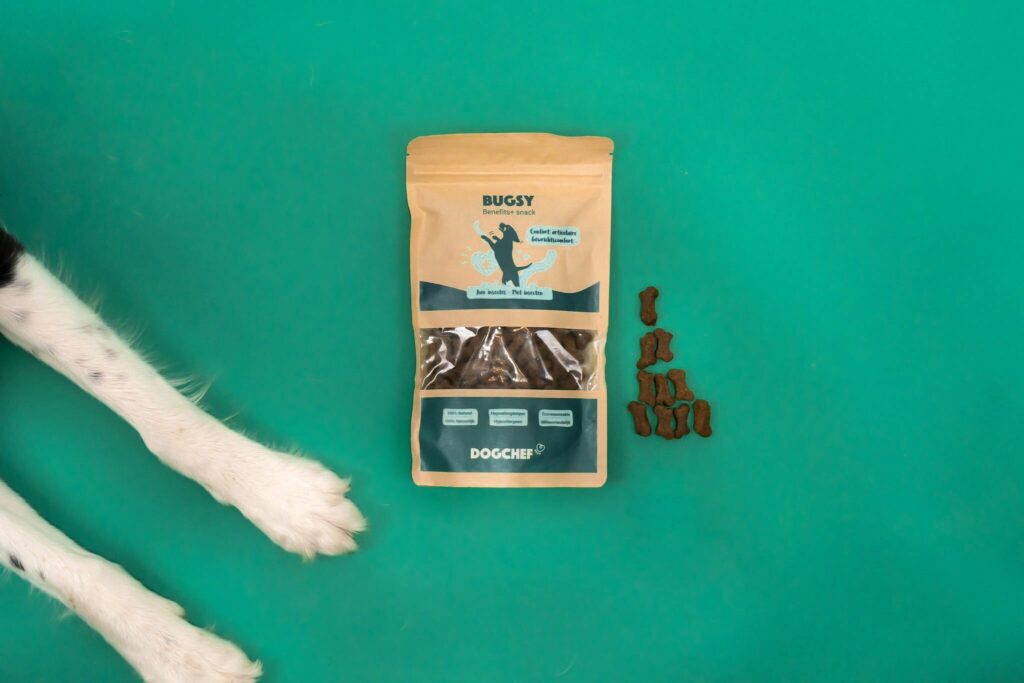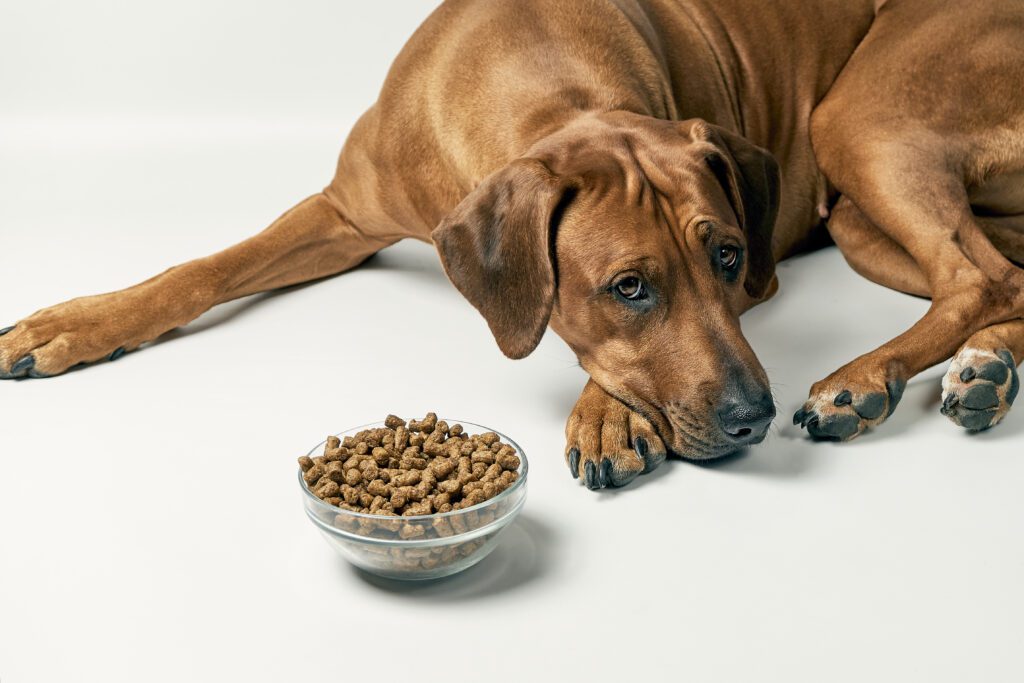Fish is packed with healthy nutrients for your dog. It is a key source of omega 3, an essential fatty acid that is good for your dog’s joints, heart, immune system, coat, skin and intestinal flora.
Sounds like every dog parent should add a fishy treat to its dog’s diet right? Sure, but there are a few things to keep in mind when you’re feeding your dog fish. In this blogpost you’ll discover how we teach your dog to eat fish, the types of fish we recommend and how to prepare them in a dog-friendly way.
Carefully remove the bones when feeding your dog fish. They tend to get stuck in your dog’s throat, which is a similar problem for humans. It’s not only a tedious feeling, it’s also very dangerous. If a stiff fishbone pierces your dog’s intestinal tract, it can be fatal.
You might indulge a sushi boat every once in a while, but your dog absolutely doesn’t. Never serve your dog raw fish. Raw fish can contain dangerous bacteria and parasites, such as Salmonella and listeria that can make your dog very sick. We recommend you to always heat your fish, so harmful bacteria and parasites won’t stand a chance.
Fish can be an important part of a home-cooked diet, although some dogs may not like it right away. Offer some small pieces of fish by adding them to a appetizing snack, to get your dog used to the taste.
Frozen fish is no less healthy than fresh fish. On the contrary: thanks to the rapid freezing, the risk of encountering harmful bacteria is drastically reduced and nutrients aren’t lost. Frozen fish is therefore healthy and safe, both for you and for your dog.
Want to treat your dog with canned fish? Then pick the cans filled with fish in water without the extra salt, since it could cause dehydration. Fish in oil is also considered a no-go because it’s too fatty for your dog. It can cause intestinal complaints or diarrhoea.
Note: some canned fish has already been cooked during manufacturing so you don’t have to cook it again at home.
Fresh fish, frozen fish and canned fish always are a safe and healthy choice for your dog as long as the fish is well heated. Find out which types of fish to serve to your dog, what the health benefits are and what to watch out for.
Tuna contains a lot of lean protein, omega 3, vitamins and minerals. These are very healthy for your dog, but it is better not to overdo it. Tuna also contains mercury, which is poisonous.
Proteins promote the muscle development of your dog: they repair damaged muscles and contribute to an intensive build-up of muscle mass.
Omega 3 promotes the general health of your dog: it ensures flexible joints, a strong immune system and a shiny coat without flakes or itching.
The vitamins B3, B6 and B12 in tuna convert food into energy, promote your dog’s digestion and increase his resistance.
Tuna contains important minerals such as potassium and phosphorus. These ensure a perfect fluid balance, healthy blood pressure and strong bones and teeth.
Tuna contains a lot of positive nutrients for your dog, but it also has a high mercury content. Mercury poisoning could lead to kidney damage and blindness. Serve your dog a maximum of 100 grams of tuna per month per 10 kilograms of body weight.
Salmon is a real vitamin bomb for your dog. However, salmon is very fatty, which turns it into a more unsuitable fish for plus-sized dogs. The natural fats in the fish also are difficult to digest, causing some animals to vomit. Our advice is to keep the portions small and to avoid serving salmon when your dog shows vomiting or needs to lose some kilos.
Omega 3 is a fatty acid that contributes to the general health of your dog. It ensures a radiant coat, an alert brain and flexible joints.
Salmon is filled with vitamins with a favourable effect on your dog. Vitamin B regulates your dog’s energy level so he remains calm, concentrated and an active waggling fellow.
No, raw salmon is dangerous for your dog for two reasons. First, it contains thiaminase. This substance breaks down vitamin B1, resulting in paralysis when consumed in large quantities. Second, raw salmon may contain a parasite carrying the bacteria Neorickettsia helminthoeca. Neorick-what? Just know that your dog can contract salmon poisoning from this bacteria. We recommend you once again to cook the fish before plating, especially salmon.
Did you serve your dog raw salmon and does he show any of the following symptoms? Then rush yourself to the vet.
If you notice the symptoms in time, salmon poisoning can be cured with antibiotics. But if caught too late, this disease can have fatal consequences for your dog.
There’s room for 5 grams of salmon for every kilogram of body weight per day in a healthy and balanced dog’s diet. That corresponds to 5 to 10% of the total dog menu.
Trout and salmon belong to the same family: the Pacific salmon. Trout, however, contains much less fat than its pinkish brother: 6 grams of fat per 100 grams compared to 14 grams in salmon. Does your dog need to lose weight? Then you might opt for trout as an excellent alternative to salmon.
Trout is known for its large amount of vitamin B, especially vitamin B3. This vitamin ensures good absorption of calcium and phosphorus and thus helps building strong bones and teeth. It also contributes to a strong immune system and prevents skin and coat problems.
Trout is an excellent source of phosphorus. It contains 220 milligrams of phosphorus per 100 grams of fish. These numbers prove that trout is an essential nutrient for building strong bones and teeth.
Supermarkets mostly sell rainbow trout, a fish with coloured flanks and a pearly sheen. Make sure the gills are shiny and the eyes are clear (not milky) because that indicates the fish to be fresh. It reduces the chance of harmful bacteria and parasites. You’ll provide your dog with a safe, low-fat and nutritious meal by steaming the fish and removing the bones first.
Seabass is a tasty and easily digestible snack for your dog. The low fat content turns sea bass into the perfect meal for overweight dogs.
Sea bass supplements any deficiencies incorporating 41 milligrams of magnesium per 100 grams of fish. Your dog will les likely suffer from muscle cramps and will convert nutrients into energy in a more convenient way.
Sea bass is a tasty, healthy and versatile fish for your dog. You can boil, steam, grill or bake it: plenty of options! However, this fish contains many bones and sharp fins. Cleaning the fish carefully is a labour-intensive job but a super important thing to do in order not to hurt your dog.
Plaice is the famous flatfish that perfectly makes part of a healthy diet for your dog. This lean fish is full of vitamins B3, B6, B12 and D that convert nutrition into energy and ensure healthy bones and teeth.
Did you know that plaice contains almost 4 times as much calcium as salmon? This mineral is essential for healthy bones and teeth. It’s a great idea to serve your dog bits of plaice every now and then, especially as he gets a little older and stiffer.
Plaice is a flat fish whose large pectoral fins resemble wings containing the meat. Remove the bones with a fork after heating the fish sufficiently.
Another treat to pamper your dog with is dried plaice. Dried fish has a longer shelf life and tends to be the perfect take away treat for your dog.
Note: dried fish is also best stored in the freezer so that your dog can relish it until one year later.
Cod is a tasty, light and soft fish, but also very susceptible to parasites. It is extra important to cook the fish well to ensure your dog not getting sick.
Cod contains 28 times less fat and 2,5 times fewer calories than salmon, with just 0,5 grams of fat per 100 grams. This makes cod a very healthy choice for overweight dogs.
Cod is widely farmed so it’s a fairly cheap fish. You can buy frozen cod fillets in just about every supermarket. These fillets of white fish have already been cleaned, which gives you more time to play with your dog! Thaw the fillets safely in the fridge, bake them well and serve them lukewarm to your dog.
Your dog is allowed to eat all kinds of fish in moderation as long as you prepare them correctly. Fish with a high mercury content such as tuna, shark or swordfish should not be put on the menu too often. Other fish species such as salmon and cod can be savoured every day, yet again in moderation, perfectly heated and with the bones removed.
Lacking time to do this yourself?



Votre navigateur est obsolète!
Mettez à jour votre navigateur pour afficher correctement ce site Web. Download Google Chrome